41 Games of the Year
Even the most cursory review of the currently available archival funds shows that the work in the headquarters of the Red Army was in full swing, there were not many military and front-line military games, but very many. Thus, only in the last six months before the actual start of the war took place (the names of the events are indicated in accordance with the relevant documents):
And this list is far from complete; this is only what was discovered during a quick scan of the documents, and the Far East theater theater was completely excluded from attention; army games and so-called army battles are not mentioned at all. Of course, the level of military districts of the “game” was not limited to, regular strategic games were also conducted with the participation of the highest command of the Red Army, during which the general plans for the use of the Armed Forces of the USSR were worked out and refined. With regard to 1941, two strategic games held in January are known (described in detail by P. Bobylev in the article “Rehearsal of the Catastrophe”, “VISH”, No. 7, 8 for 1993 a year) and the mysterious May game (see M. Solonin, “ Unknown game May 41-th ").
"Orange" is not considered neutral ... "
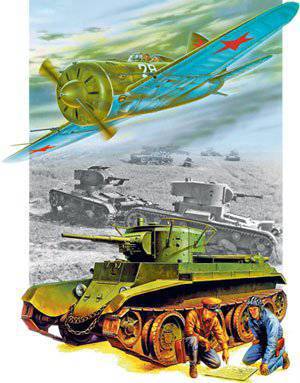 If paleobiologists reconstruct the appearance of a dinosaur on several fragments of bones, then for a military historian, the reconstruction of the Great Plan does not pose an insurmountable problem on the basis of documents from the district (front-line) operational plans and staff games. For example, it does not take long to guess why 12 – 20 in March 1941 was a joint field trip of the headquarters of the Leningrad, Ural and Orel districts. Yes, on a geographical map these districts are separated by hundreds of kilometers, but as part of the plan of war with Finland * they had to work together “to invade central Finland, defeat the main forces of the Finnish army and capture the central part of Finland”. For the defeat and mastering, it was planned to deploy four armies: the 7 and 23 of the troops of the Leningrad region, the 20 on the base of the Orlovsky and 22 troops on the basis of the Ural district troops.
If paleobiologists reconstruct the appearance of a dinosaur on several fragments of bones, then for a military historian, the reconstruction of the Great Plan does not pose an insurmountable problem on the basis of documents from the district (front-line) operational plans and staff games. For example, it does not take long to guess why 12 – 20 in March 1941 was a joint field trip of the headquarters of the Leningrad, Ural and Orel districts. Yes, on a geographical map these districts are separated by hundreds of kilometers, but as part of the plan of war with Finland * they had to work together “to invade central Finland, defeat the main forces of the Finnish army and capture the central part of Finland”. For the defeat and mastering, it was planned to deploy four armies: the 7 and 23 of the troops of the Leningrad region, the 20 on the base of the Orlovsky and 22 troops on the basis of the Ural district troops.These tasks — hardly compatible with the spirit and letter of the Soviet-Finnish peace treaty of 12 in March of 1940 — were worked out during a field trip, which was directly stated in the Directive of NPO No. OP / 503596 of 28 in March of 1941 of the year: “During a field trip the FRONT STAFFING OPERATION was worked out (in capital letters, in the original document. - M.S.) under difficult winter conditions ... The main purpose of the field trip was to check the preparedness of the front and army departments in organizing and conducting the modern operation in the winter in condition s Karelian-Finnish theater. " The level of secrecy with which the field trip was conducted is noteworthy - even a sealed safe in the headquarters of the Leningrad District seemed to be not a reliable place for the subsequent storage of such documents; On April 3, the Chief of the General Staff (i.e. Comrade Zhukov) orders the Chief of Staff of the LenVO "to submit to the Operational Directorate of the GSH by April 10 an act on the destruction of tasks and maps on a field trip to the LenVO [held] in March 1941. cards to them return to the OU GSH. "
Of particular interest are the operational games conducted by the command of the Kiev OVO (the future Southwestern Front). It was this front that was to deliver the main blow in the direction Lvov - Krakow, it was there that the most powerful grouping of the Red Army troops (in particular, exceeding in number tank divisions and tanks of "new types" three other districts / fronts combined). Alas, this particular interest was foreseen by someone, and among the archival funds that have been declassified at this time, there are neither tasks for operational games in KOVO, nor descriptions of the course of such games. All the currently available "body of information" comes down to a few fragmentary references to the game held in May 1941.
So, on April 26 of 1941, the head of the operational department of KOVO headquarters, Colonel (future marshal) Bagramyan reports to the head of the General Staff Directorate: “I present the tasks for command-and-staff exercises with the 5 and 6 Armies and front-line operational game. Applications: tasks on 115 sheets ... plan for conducting front-line operational games on 7 sheets ... situation map for 18.00 12 in May ... general situation map for 12.00 in May 6 ... "30 in April 1941, deputy head of General Staff Major Anisov sends the following telegram to the Chief of Staff of the Red Army Air Force: “During the period 12 – 18 in May 1941, command and staff exercises of the headquarters 5 and 6 Army KOVO are held. For these exercises, it is advisable to attract the headquarters of the 2 th air corps as part of 7 people. I ask you to give instructions ... ”4 May 1941, the deputy head of the General Staff, Lieutenant General Vatutin, sends a response telegram No. OP / 1409 to the headquarters of the Kiev district:
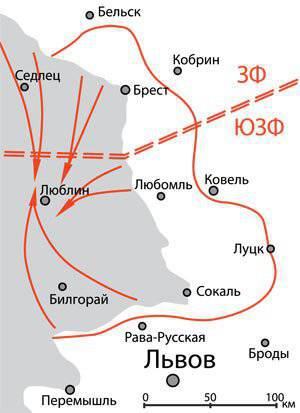 1 card
1 card“To amend the task and plan of the front-line operational game. 1) “Orange” should not be considered neutral, but should be counted from the first stage of the game on the side of “Western” ones. 2) The organization and forces of the "Orange" take real and strengthen one army corps and a tank division "Western". 3) At the last stage, the southern front should not be created, leaving the 16 Army under the control of the South-West Front. I remind you to take all measures to preserve the secrecy of the game. ”
That's all that is known. We can only assume that taking into account the chronology of events (the game in KOVO was held from 12 to 18 in May, and the strategic “May game” took place in 20's numbers in May 1941) and special attention paid to the actions of the right-flank 5 and 6 th Army - during the operational game in Kiev, a “fragment” of that big strategic operation that was played out during the May game was worked out. On the map, it looked like this (1 map).
Having forewarned the "eastern" in deployment, the "western" began the war ...
Within the framework of the overall strategic plan of the war, the troops of the Baltic ObVO (North-Western Front) were to solve defensive tasks (in some variants of the Big Plan, supplemented by a private offensive operation to “cut off” the Suwalki bulge). And somehow it turned out that it was precisely for command and staff exercises in the Baltic PSB that there was a significant body of documents available to historians.
In February, a district operational game was held in PribOVO on the theme “A defensive operation of the front with a subsequent offensive to destroy the enemy”. The assignment approved by 1941 in February prescribed the following situation to be played:
The "Western", warning the "Eastern" in the deployment, 5.6.41 began the war. The “western” strike the main blow in the south, against the Ukrainian (as in the text. - MS) front, while simultaneously concentrating large forces in East Prussia, where it develops a strike in the Šiauliai and Kaunas directions. Against the North-Western Front, at least 30 infantry divisions with tanks and a large aviation... To the south, the troops of the Western front of the “eastern” continue to concentrate for a strike in the western direction, successfully repulsing parts of the cover of the “western” attempt to cross the state border. Border with the Western Front: Polotsk, Oshmyany, Druskeninkai, Suwalki, Letzen ... "
So, according to the terms of the “game,” it happened just what happened in June of 41 in real stories. At least that is how 10 June described the situation in the 22 in the morning as an operational summary of the Red Army General Staff number one: “The enemy, having preempted our troops in deployment, forced the Red Army to accept the battle in the process of occupying a starting position under the cover plan ...” More One feature of the similarity of the game assignment and the real events of June 41 is manifested in the fact that the troops of the North-Western Front "Eastern" are scattered at a great distance from each other; The two first-tier armies comprise no more than half of the total number of front-line units (15 from 33 rifle divisions, 4 from 7 tank brigades, 6 from 11 individual artillery regiments).
This, in fact, the features of the similarity of the game and no one at that time of a known future end. Further serious differences begin. First of all, the compilers of the game task made a radical mistake in determining the direction of the main attack of the enemy: there (in the Belarusian direction), where in reality the Germans concentrated their main forces, according to the conditions of the game, the “western” are marking time, unsuccessfully trying to cross the border. At the same time, the troops of the Western Front of the "Eastern" slowly "finish concentration and prepare for the transition to the offensive at the end of June." It is noteworthy that this mistake clearly coincides with the misinformation that the German intelligence services used to throw Soviet intelligence in all available ways: allegedly the German command plans a grand coverage of the Red Army with the main attack on the northern and southern flanks, through the Baltic States and Bessarabia.
Unlike what will happen in reality, the troops of the “Western” are also deeply echeloned, while in the second echelon almost half of all forces are concentrated (18 from 39 infantry divisions, 4 from 5 tank divisions, 2 from 2 light divisions, 9 from 22 artillery regiments). Mobile units (tank and light divisions) are almost completely withdrawn to the second echelon and patiently wait for the infantry and artillery of the first echelon to penetrate a rather wide “breach” in the defense of the “eastern”.
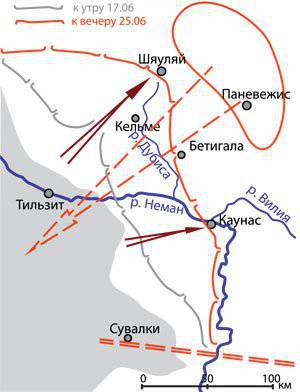 2 card
2 cardAnd yet the most incredible from the point of view of our current knowledge about the events of the initial period of the war is the chronology of the events of the operational game. The conditional “war” begins on June 5, after which the “western” spend 12 days (!!!) to reach the main defensive zone of the “east”, which lies 30 – 40 kilometers from the border (2 map). Moreover, this stage of “combat operations” during the game was not worked out at all, it is only briefly mentioned in the assignment.
The combat actions played during the exercise begin with the conditional 17 of June. The "Western", concentrating on the 60-kilometer section of the breakthrough (from Kvedarna to Tauragen) 12 infantry divisions against the 3 rifle divisions of the "Eastern", by the end of June 18 break through the front. A tank avalanche of unimaginable numbers rushes into the resulting gap - more than 4 thousand tanks ** (in real history, the 4-I Wehrmacht tank group operating on Šiauliai was armed with 650 tanks and self-propelled guns). From 18 to 25 June, the “eastern” with stubborn battles depart to Siauliai. To the south, on the Kaunas direction, where the enemy has “only” 10 infantry divisions and 725 tanks, the “eastern” depart and are fixed on the left (western) bank of the Neman.
At the second stage of the game (from the conditional 25 of June to 3 of July), the offensive of the “Western” was stopped everywhere, the front stretching for 420 kilometers stabilized. Receiving significant reinforcements (5 rifle divisions), the conditional 1 Army of the "Eastern" (for which the headquarters of the real 8 Army of PribOVO played) put a counter-attack on the enemy and threw it away from Šiauliai. Meanwhile, in the operational rear of the "eastern", in the Panevezys-Jelgava line, fresh concentrations of the Red Army, redeployed from the depths of the country, are concentrated. At the same time, the command of the "eastern", showing iron restraint, does not throw suitable parts directly from the echelon to the front for the feverish "plugging of holes" (this is what the Soviet command has been doing all summer 1941 of the year in real history). The only thing that was done: anti-tank artillery divisions (18 PTO guns in each) were withdrawn from the six rifle divisions of the second echelon of the front, of which a mobile combat group was formed, which halts the advance of German tanks to Šiauliai.
By the morning of July conditional 3, the concentration of the "eastern" strike group was completed. The overall balance of forces at this point is as follows: the "Eastern" 43 rifle, 4 tank and 2 motorized divisions, 11 tank and 5 motorized brigades; the "Western" 39 infantry, 5 tank and 2 light divisions. On military equipment: the "Eastern" 6614 tanks and 4358 guns, the "Western" 6525 tanks (incomprehensible to the mind - where could they come from in such numbers?) And 3624 guns. As we can see, the forces are almost equal, although half of the “eastern” formations are fresh troops that did not suffer losses in previous battles.
The crushing blow of the "eastern" forces the "western" to a hasty retreat. For three days (3, 4, 5 of July), the "eastern" are moving 100 kilometers, from Šiauliai to the border. The Kaunas group of “Westerners”, which turned out to be in a semi-circle in the bend of the Neman, throws heavy equipment and breaks into East Prussia with battles. A curtain.
On not knowing the airfields
Deserves attention and description of the actions of the Air Force of the parties. In the task for the game we read:
“Western“ air forces ”with 5.6 raids on 20 – 30 airplanes operate on“ eastern ”airfields, located south-west of the Jelgava, Panevezhes, Shvenchenis line, railway nodes, unloading stations and railway bridges, and“ eastern ”troops in the region of Jelgava, Panevezys, Šiauliai, preventing their concentration. The operation involves 1100 – 1200 airplanes, of which 50% are fighters.
Air forces of the “eastern” with 5.6, covering the concentration of their troops, are fighting the enemy aircraft in the air and on the ground, especially stubborn battles take place on the Siauliai direction, where there is simultaneous participation in air battles of 150 – 200 aircraft; fighting the enemy’s operational shipments, acting on railway junctions, unloading stations and freeways, operating along enemy troop concentrations in Tilsit, Insterburg, Gölärd, Gumbinen and at the ports of Memel, Karkeln, Labiou and Pillau ”.
In order to have time to solve such a wide range of tasks at the same time, combat aircraft of the "eastern" works with an incredible (if compared with the reality of the 1941 – 1945 air war) intensity, So, during the conditional 14 – 18 of June, the Eastern air forces carry out six (!) fighter flight regiments, from 2 to 4 flight regiments of bomber and attack aircraft per day.
However, the most surprising thing is the losses that the "Eastern" air force suffered at such intensive combat use (and after repeated 20 – 30 air strikes of the enemy aircraft on the airfield, moreover). By 18 June, the 6-I mixed aviation division has a shortage (which, strictly speaking, is not equivalent to the word “loss” - the division could have some shortage of aircraft before the outbreak of “hostilities”) 68 aircraft, 254 aircraft are in combat readiness; 2-I GARDEN - incomplete 65 aircraft, in the 254 aircraft also in the ranks; 1-I GARDEN - incomplete 51, in the 268 order. And this is the hardest loss. Other aircraft divisions lost from 17 to 45 aircraft. In general, the shortage (loss) of the Air Force "eastern" to the conditional 18 of June is 322 of the aircraft or 17 percent of the number remaining in the ranks.
From 22 to 27 June, three more air divisions (a total of 420 fighters and a 473 bomber) are included in the Air Force "Eastern", which, as we see, is more than covering losses; by the beginning of the July offensive at the "eastern" already 2833 aircraft in service. Aviation "Western" by the time somewhat weakened, they have "only" 2393 aircraft. It only remains to recall that in reality, the Luftwaffe air fleet as of 1 June 22 was included in the 1941 air fleet, including the defective, 434 combat aircraft.
Second attempt
Compared to what happened in real June 41, the events of the “game June” seem like a sweet fairy tale today. The high command of the Red Army did not look at them that way at all - the documents contain a long list of identified shortcomings, shortcomings and mistakes in the actions of the headquarters and conditional "troops". For this or for any other reason, but a front-line field trip conducted in PribOVO from 15 to 21 on April 1941 was devoted to working out the same task: “The defensive operation of the front and armies under the conditions of the onset of large enemy forces with incomplete concentration of their troops; conducting a counterstrike with forcing a river obstacle. " The geography of conventional "combat operations", the direction of strikes and the lines of defense of the parties almost completely coincided with the February game on the maps.
Some differences — moreover, to the useful side of giving the teachings greater realism — are observed only in quantitative terms. First, the “Western” offensive is developing this time noticeably faster: having started the operation on the morning of April 17 (the game and the real time of the field trip were the same), by the end of the day April 22 crossed the Dubis River and occupied the city of Prienai on the left (western) bank of the Neman ; the rate of onset was about 15 – 20 kilometers per day. Secondly, the number of rifle divisions (11 units) in the two armies of the first echelon of the "Eastern" exactly coincided with the composition of the real 8 and 11 Army PribOVO; just like in the real June of the 41, the entire 8 rifle divisions were directly in the border strip. Closer to the real (although still overstated) was the composition of the "Western" grouping - 30 infantry divisions, 6 tank and 2 motorized (22 June 1941, the German Army Group "North" included 20 infantry divisions, 3 tank and XNNXXNNXXNNXXNNXXNNXX and NNXX infantry divisions, 3 and XNUMX XNUMX tank divisions motorized).
It is noteworthy that this time Oriental aircraft performs conditional “combat” 5 fighters and 12 bomber departures for 8 days, and even this voltage level is estimated by inspectors from the General Staff as “somewhat overstated departures”. In general, everything was completed successfully, the enemy received a counterblow from Kelme, Betagola to the south, to the Neman (though crossing the river, originally envisaged by the task, was not worked out during the field trip). The inspectors noted the increased - as compared with the February game - coherence of the work of the headquarters and wrote another long list of comments.
Not standing aside and 3-e NPO (military counterintelligence). 16 in May 1941, Assistant Chief of 3-th Department of State Security Captain Moskalenko sent a report to Vatutin on the “Shortcomings in the operational field trip of the Baltic PSB”. Noting a number of mistakes in ensuring secrecy, covert control of troops and protection of headquarters, the “special person” drew attention to the most important thing: “The operational task was drawn up following a template. The same theme carried out on army trips (a defensive operation with limited forces and means, followed by a counteroffensive), and each time gave the enemy the opportunity to break through our defenses with large forces, and then these large forces stopped and waited for our counterattack ... "
The next front-line field trip took place in PribOVO from 3 to 8 June. The report on her "senior group of commanders of the General Staff of the SC" Colonel Enyukov signed on Monday, June 16; before the beginning of the present war there was less than a week. The theme of the exercise is the same: “Organization and conduct of a counterblow in a front-line defensive operation with forcing a river obstacle.” The idea of the operation and the direction of blows of the parties have changed somewhat:
“The Northeastern Front of the“ Western ”as part of the 4, 13 and 7 Army (ten army corps and two mechanized corps) at the end of May crossed the state border and is developing an offensive in the Kaunas direction on both banks of the r. Neman. The North-Eastern Front "Eastern" (9-I and 5-I Army, thirteen rifle divisions) under the onslaught of superior forces of the enemy departs, at the same time creating a strike force (16-I Army consisting of six rifle divisions and two mechanized corps) in the Siauliai region for striking the flank and rear of the “Westerners” operating in the direction of Kaunas ”.
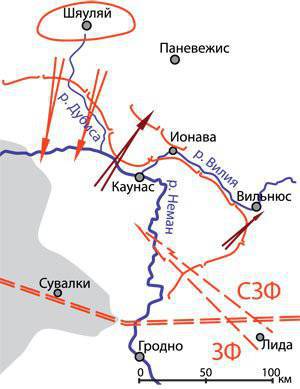 3 card
3 cardIn the early days of the conventional war, the affairs of the “Oriental” are very bad. 14.00 3 June “Westerners” advanced 150 kilometers east of the border, forced the Dubis river, forced the Neman on a wide front from Sredniki to Druskininkai, reached the western suburbs of Vilnius and strive to build on their success by attacking tank formations through Kedainiai to Panevezys (NN map) (NN map) .
However, this time the hostilities of the most difficult first days of the “war” are not played out, they are only mentioned in the field trip assignment. The game begins with 3 June. The "Eastern", in the grouping of which anti-tank artillery brigades appear for the first time, push them into the Kedainiai, Jonava area and in the fierce battles 4 and 5 of June stop the advancement of the "Western" towards Panevezys. At the same time, in the area of Kryazhay, Tytuvenai (that is, on both sides of the Dubis River), the "eastern" are concentrating the shock grouping of two mechanized corps (in reality, they could be the 12 and 3 of the PribOVO mechanized corps) and deliver a crushing blow to the flank the adversary.
By the end of the day 5 June tanks "Eastern" go to the Nemunas in the Jurbarkas band, Sredniki (now Syaryadzius). Two days later, infantry approaches (six rifle divisions) approach the Neman and successfully force it, leaving the Western grouping that had broken through to Vilnius. At this "game" was completed. The report states cheerfully: “On this field trip, one of the PribOVO troop actions by the“ western ”main attack in the Kaunas direction was worked out with a double ratio of forces (for example, the document refers to the double numerical superiority of the“ western. ”- M. WITH.). The issue of using the PTARB has been worked through. ”
Concluding the brief review of the field trip for the command of the Baltic OVO, it is worth noting that the operation played out in it almost exactly coincides with the situation on the North-Western Front that took shape during the strategic “May game”. The only difference is that in May the “Western” who broke through the Neman to Vilnius received three hits from three directions: the 12 Mechanic Corps advanced from Šiauliai to the south, the Western Front 11 Mechanical Corps struck from the city of Lida to the north-west , to the right flank of the enemy, and the 3 th mechanized corps of the North-Western Front, prudently relegated earlier to Shvenchenis, delivered a “head-on” blow to Vilnius. It can be assumed that such a dispersal of forces was recognized as erroneous and in the operation played during the June field trip, two mechanized corps of PribOVO were combined into one strike fist.
* Considerations for deploying the Armed Forces of the Red Army in case of war with Finland from 18 September 1940, Directive of the USSR and General Staffs of the Red Army to the Commander of the Leningrad VO to develop an operational deployment plan for the North-Western Front from November 25 of November 1940, Directive of the NPO of the USSR and General Staff of the Red Army commander of the Arkhangelsk VO troops to develop a plan for the operational deployment of troops of the Northern Front, b / d
** At first glance, a huge number of tanks strongly does not coincide with a very modest number of "Western" tank divisions. Here, however, we must bear in mind that Soviet intelligence doubled the standard number of tanks in the Wehrmacht’s tank division, estimating it in 450 units. Secondly, the compilers of the game assignment included in the composition of each army (infantry) corps of the Wehrmacht a certain “separate tank regiment” with 275 tanks.
Farsightedly traced in September 1939 of the year (at the signing of the Soviet-German Treaty of Friendship and the Border), the Belostok salient to the depth of 120 kilometers crashed into the territory of the German-occupied Poland. Such an outline of the border opened up a wide range of opportunities for the Red Army.
Without making a single shot, the Soviet troops were deep in the rear of the Suvalk and / or Lublin enemy grouping. At first glance, especially if you look at an extremely simplified map, the bright prospects were promised by a blow in the north-west direction, from the “tip” of the Belostok junction to Allenstein (now Olsztyn): there are no large rivers on the way. the edges of the Baltic coast are less than 200 kilometers, with one blow it was possible to cut off from Germany and surround the entire East Prussian grouping of the Wehrmacht.
Burden of choice
Everything changes if you look at the military topographic map: in the eyes of you there are countless blue spots ... Suvalkiya and Mazovshe is the land of dense coniferous forests and countless large and small lakes. An ideal place for hiking and boating, but fighting there is incredibly difficult. In such a place, the Red Army inevitably lost its main "trump card" - huge herds of high-speed light tanks, stuck in narrow inter-aisle passages, on the marshy banks of forest streams, Soviet tanks would have become a fixed target for guns of German VET.
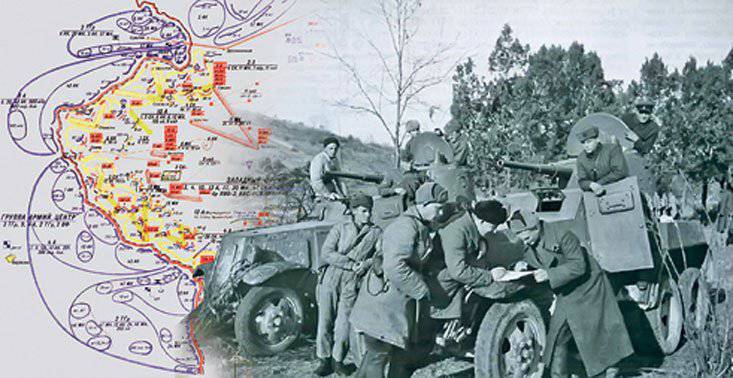
A serious problem for the attackers is created not only by geography, but also by the history of this region, which for many centuries was the scene of the military rivalry between the Polish-Lithuanian Commonwealth and the German knightly orders. Hundreds of years they built, built and built all sorts of fortifications there (by the way, the largest medieval fortress in Europe is located there, in Malbork, German Marienburg). After the division of Poland into these places, the border line between the Russian and German empires was crossed, and there, with new force and new technical capabilities, they began to build fortresses and pillboxes. In the end, the southern strip of East Prussia turned into a huge, almost insuperable fortified area.
Nevertheless, the temptation of a simple solution (to encircle East Prussia with one blow) was so great that the option of an attack on Allenstein and further to the sea was repeatedly considered: in the August and September (1940) versions of the strategic plan of the Red Army, during the operational game in the Western PSB (September 1940) and in the first of two January (1941) strategy games. But ultimately, the Soviet military-political leadership came to a firm decision to abandon the "northern option", since "the struggle on this front can lead to protracted battles, will tie our main forces, will not give the desired and quick effect."
The direction to the south of the Bialystok salient also created serious problems for the advancing army — three rivers (the Narew, the Bug, the Vepsh) stood in its way, and in their lower, that is, the most affluent course. The very topography of the future theater of military operations led to the only rational decision - to go to the Vistula approximately at a hundred-kilometer stretch between Warsaw and Demblin (that is, between the mouths of the Bug and Wepsch rivers). It was this course of action with different variations that was worked out in 1941 during the command and staff exercises of the Western PSB.
Warsaw direction
The first of the now famous front-line operational game of the Western OBO was held from 15 to 21 in March. Subject: "The offensive operation of the front and the army." The calendar and conditional time in this game is the same (in the task for the game we read: “Longitude of the day, weather conditions and road conditions are real in the days of the game”). Conditional "fighting" began in the morning of March 16. The Directive of the Western Front Command No. 027 set the following tasks for the "Eastern" troops:
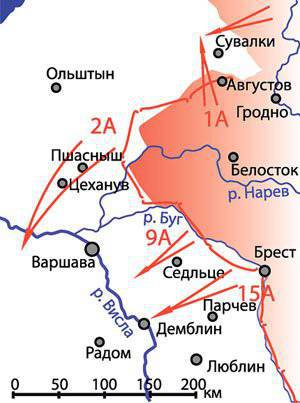 1 card
1 card“The troops of the Western Front to carry out a private operation to capture the Suwalki bulge, securely covering the 1 Army from the north, complete (I emphasize. - MS) the rout of the opposing enemy and go to X. NUMX on r. Wisla is in readiness for a subsequent strike in the direction of Lodz (23.3 kilometers south-west of Warsaw. - M.S.) for the defeat together with the South-Western Front of the main forces of the Warsaw-Sandomierz "Western" group (130 map).
The words about the "completion of the defeat" are not an accidental reservation. The preceding events were described in the introduction to the game as follows: “As a result of the oncoming battles, the Western Front’s“ Eastern ”troops repulsed the“ Western ”offensive and, launching a concentrated counter-offensive, defeated the opposing enemy grouping by the end of 15.3. Pissa, p. Narew, p. Bug The position of the troops according to the Western Front Operations Command No. 017 from 15.3.1941. ”
At the same time, the “counter battles” and the “offensive of the“ Western ”were not described in any way, and certainly not worked out during the game. Everything happened easily and simply, as can be judged by the losses of the "Eastern" tank formations indicated in the introduction to the game. Before the start of the “combat operations” of the game (by the end of March 15), 8 tank divisions and 20 tank brigades of the “Eastern” - and according to the staffing schedule this is about 7,5 thousands of tanks - irrevocably lost all 73 (!!!) tanks. One percent of the original strength. In eight tank formations there are no irretrievable losses at all. Even taking into account 396 tanks sent for medium and major repairs, the specific losses of the "eastern" are negligible.
But this is not limited to the extraordinary success of the “oncoming battle”. The boundary of the rivers Pissa, Narew, Bug - this is the border line agreed with Hitler in September 1939 (more precisely, the “line of delimitation of state interests of the USSR and Germany on the territory of the former Polish state” - this is exactly what was called in the documents). However, if we take the Operational Summary No. 017 mentioned above and find Ksebka, Kadzidlo, Krushevo, Brok, Sarnaki and Ossuvka townships mentioned in it, it will be seen that the “eastern” not only dropped the “western” to the border, but also crossed to the opposite bank of the border rivers. Moreover, they did it on two sectors that were critical for the upcoming offensive: north-west of Ostroleka (at the tip of Belostok projection) and north-west of Brest, where the “east” were located behind the Bug, 10 kilometers from the Polish city of Biala-Podlaska.
Such an amazing coincidence of the results of the short (from 12 to 15 of March) "counter battle" with the optimal for the "eastern" line of the initial position of the troops to advance from the border to the west makes, in my opinion, a reasonable assumption that no one will repel the invasion of "western" and was not going to. Mention of him is a ritual phrase, a fig leaf, which was supposed to hide the real plans of the high command from the persons allowed to play (it is worth noting that the circle of informed persons was very wide and even the task for the game was made typographically in the form of a brochure on 99 sheets). For the commanders of the middle level, the conditional “war” was supposed to begin strictly according to the Charter: “If the enemy imposes war on us, the Workers 'and Peasants' Red Army will be the most attacking army that has ever attacked. We will conduct the war offensively, with the most decisive goal of completely destroying the enemy on his own territory ... "(Field Regulations, PU-39, chapter of 1, paragraph 2).
A giveaway game?
In order to realize the decisive goal of complete defeat, an unrealistically large number of formations were included in the “Eastern” Western Front: 67 (sixty-seven) rifle divisions and 3 cavalry divisions, 4 mechanized corps and 20 tank brigades. So it still seemed a little, and during the "game" the front received reinforcements as part of the 21 rifle division and 8 tank brigades. Never, according to any of the known plans of the strategic deployment of the Red Army, nor according to one of the statements of the distribution of forces of such a number of infantry for the Western Front, the real figures are in the range from 41 to 24 rifle divisions. Yes, 198 rifle divisions were part of the Red Army, and abstractly arguing, 88 divisions could be found for the Western Front, but this is a completely different alignment of forces, suggesting a completely different plan of war.
According to the scenario of the March "game", the enemy in the Western Front had only 33 infantry and 2 tank divisions in the first echelon and 6 infantry divisions in reserve in the Warsaw and Neidenburg area (now Nidzits - 80 kilometers north-west of Ostrolenka). Continuing to "play in the giveaway," the compilers of the assignment write: "In the direction of Augustów, the Sedlec enemy uses only medium and light tanks of old models." In other words, there is simply nothing to counterattack the advancing armada of the “eastern” Germans.
With such an introductory result of the game turned out to be quite expected. Within six days, the "Eastern" in tatters crushed the "Western". The main striking force of the Western Front, 2-Army (24 infantry and 3 cavalry divisions, 2 Mechanized Corps - not every front during World War II had the number) has made in-depth coverage of the Warsaw grouping enemy through Przasnysz, Ciechanow got to the Vistula and crossed it. Slightly less numerous 15-I Army (20 rifle divisions and 2 mechanized corps) advanced 130 kilometers from Brest to Demblin and is preparing to force the Vistula to join the 2-th Army troops with a ring of environment around the defeated enemy. To complete the picture, the "eastern" landed large airborne assault forces, which quickly captured the Vistula crossing.
The war in the air was described in an uncommon way in the game assignment. The “Western” air forces in the period of 12 – 15 of March were actively operating on troops, railway nodes and airfields. During the 13 – 15 March period, the Eastern air forces continued (emphasized by me. -M.S.) to fight for air superiority, covered the 2 Army’s strike force, interacted with ground forces to destroy the enemy’s retreating forces, stopped railway transportation , destroyed aircraft [of the enemy] at the airfields and did not allow the enemy’s reserves to approach the front along dirt roads. ” It is not clear what the aircraft of the “eastern” 12 of March did and when it began what “continued” 13 – 15 of March. In any case, having 5657 airplanes (four times more than it was in real June 41) against 2611 airplanes of "western" (twice as many as it was in reality) and, of course, did not disappear without a trace after the first strike on their own airfields, the Eastern air forces successfully solved all the tasks assigned to them: they won the air superiority, interacted, stopped, destroyed and prevented ...
April "fly"
For the sake of truth, it must be admitted that the General Staff of the Red Army very quickly realized that there was little practical use in the command-staff game with an outrageously overpriced own troops. The last "volleys" of the March "game" did not have time to fall asleep, as 20 March 1941, the Deputy Chief of the General Staff, Lieutenant General Vatutin, approved the "Task for the decision of the army patrol". This interesting document was sent to 1 – 3 in April to the headquarters of nine (!) Military districts. The commanders had to analyze the situation as a result of conditional "combat actions", decide on the commander of the conditional 3 Army of the Western Front and prepare the corresponding combat order. Deadline (for different districts) - from 13 to 20 April.
And the “war” this time was this: “Westerners”, having suffered a defeat on the front of Grajewo, Brest (that is, from the northern to the southern bases of the Bialystok salient), departed in the Warsaw direction, covering the approach and concentration of reserves. 15 May 1941. The "Western" launched an offensive:
a) from the area of Wyszków, Ostrow Mazowiecki by forces of 15 – 20 infantry and 2 tank divisions in the general direction of Bialystok;
b) from the area of Lublin, Kock, Demblin by 25 – 30 infantry and 2 – 3 tank divisions in the direction of Brest.
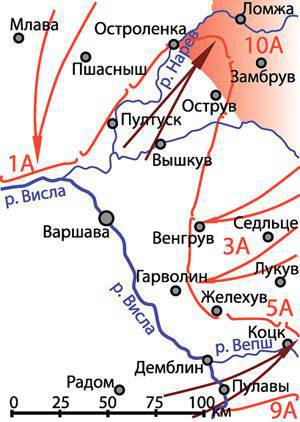 2 card
2 cardIn the direction of Przasnysz, Modlin and Siedlce, Warsaw, the “Western”, under pressure from the “Eastern”, continue to withdraw, putting up stubborn resistance on the previously prepared lines.
The Western Eastern Front (1, 10, 3, 5 of the Army) in a battle at the turn of the Narev and Bug rivers defeated the Western and develops an operation with a target of 1 and 3 with a concentric strike Armies in the direction of Warsaw defeat the Warsaw group of "Western" and go to the river. Vistula by the end of 20 May ... "(2 map).
As you can see, the overall plan of the operation and the direction of the main strikes of the "eastern" fully coincide with the March "game" in the Western PSB. As before, defeating the “Western” Warsaw grouping is planned by a concentric blow of two armies, one of which (1 on the game) leads the offensive north-west of the Narew River and goes to the Vistula west of Warsaw, and the other (3 on the game) breaks through Vistula from the southern contour of the Bialystok ledge, through Siedlce, Lukow. The other two, much smaller in composition army (10 and 5-I for the game) are connected by enemy forces at the junction between the two shock armies of the Western Front and the neighboring South-Western Front.
At the same time, the task for the April "fly" has two significant differences from the March "game". One of them is clearly visible on the map: the enemy this time is not limited to passive defense, but resolutely counterattacks with large forces, striking at the two weakest armies of the Western front and achieving significant success (in the Ostrolenka, Ostrow-Mazovia actions "transferred to the Soviet territory).
Secondly, the correlation of forces is completely different: in the 10 Army Band, the “Western” had almost double the numerical superiority (15 – 20 infantry and 2 tank divisions against the 9 rifle divisions and one “Eastern” mechanized corps), in the south, in the 5 band Army's superiority "Western" is simply overwhelming (25 – 30 infantry and 2 – 3 tank divisions against 6 rifle divisions “Eastern”). As a result, “on the morning of May 15, the troops of the 5 Army, met with a counterattack on the River Vepsh, began to withdraw to the r. Tysmenitsa; the left flank is broken in the area of Stokek, Lublin, in the gap between the 5 Army and the 9 Army of the South-Western Front are attacking enemy tank and motorized formations ”.
As already mentioned, the mission was sent to nine military districts. In this list, and close neighbors Zapovo (Baltic and Kiev districts), and the most distant, including the Siberian and Central Asian (although it would seem - where is Vistula and where is Amu-Darya?). There is only one district in the list whose troops conduct conventional “military operations”. In my opinion, the only explanation for such an incident can only be that the command of the Western PSB worked out the above-described scenario of the war in more detail, most likely during a district operational game or field trip. But documents on these events have not yet been found.
On the eve of the disaster
About the command and staff exercises of the Western PSB in May of the 41, virtually nothing is known. Little more is known about the big strategic “game” of May 1941, but there is a map and even it alone allows us to draw some important conclusions. At the junction of the Western and Southwestern Fronts, the events of the May “game” developed as follows (3 map).
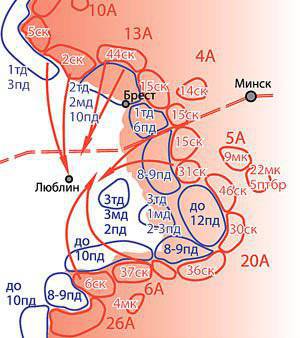 3 card
3 cardAs we see, the plans of the high command of the Red Army have become more modest, and the mood and expectation are very alarming. The red arrows no longer reach for Warsaw and beyond the Vistula (and even more so there are no fights on the map for Budapest and Timisoara, which were played cheerfully on the strategic “game” in January). Worse, the enemy manages to invade Soviet territory, and on the northern flank of the Southwestern Front, the line of maximum advancement of the “western” reaches Kovel, Lutsk and Berestechko (70 – 80 kilometers east of the border).
The actions of the main grouping of the Western Front boil down to delivering two blows strictly to the south, through Siedlce, вuków and Biala Podlaska, Parchev in the general direction of Lublin. There, they meet with the shock grouping of the South-Western Front and close the ring around the "Western" ones surrounded in the Chelm, Krasnystav area. The composition of the Western Front was taken quite realistic (realistic for the completed or close to that strategic deployment of the mobilized Red Army, and not for the “surprise attack” situation).
We still do not know - what conclusions were drawn from the results of the strategic May "game", what decisions were made (more precisely, communicated to the performers) during the meeting of the senior commanders in Stalin's office 24 May 1941. The last pre-war weeks are still one of the most mysterious periods of Soviet history. Especially noteworthy are the six documents that were found in the archives of TsAMO, f. 28, op. 11627, d. 27, ll. 160 – 165. These documents are three huge maps and three small sheets of paper attached to each of the maps (4, 5, 6 maps).
The maps contain the “situation on the operational field trip” of the headquarters of the 3, 10 and 4 armies of the Western PSB, respectively (on the instructions of the field trip, they have the numbers 19, 21 and 22). The General Staff of the KA card with a short “escort” received, respectively, 4, 5 and 12 of June. The game time was set as follows: from the conditional 13 to 18 of June - for the 3 Army, from 16 to the 23 of June - for the 10-th Army, from 26 to the 29 of June - for the 4-th Army. Whether practically all or at least some of these trips have been carried out is unknown *.
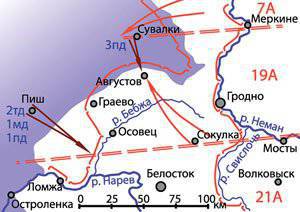
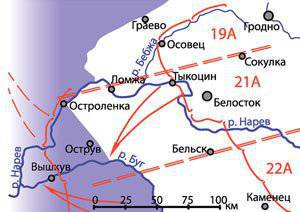
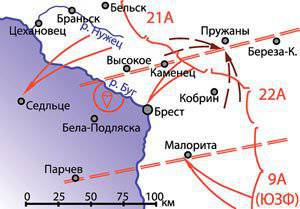 4, 5.6 Cards
4, 5.6 CardsAn extremely interesting phrase is found in the cover letter to the map of the field trip of the 3 Army headquarters. Major-General Semenov, deputy chief of staff of ZAPOV, reports: “In connection with the call of the commander of the troops to the People’s Commissar of Defense on 11.6, the field trip was postponed and will be conducted from 5 to June 9”. This phrase is interesting because it allows you to remove one of the riddles of June 41. Judging by the journal of Stalin’s office visits, in the evening of June 11 he met with the commander and the Emergency Situations Council of the Baltic PSB. And this is quite strange, since no other district commanders in Stalin’s office after the 24 meeting in May and up until the start of the war did not appear. Why would such special attention to the district, which, as can be seen from the currently known plans, was far from the direction of the main attack? Now it becomes clear that Kuznetsov and Dibrova did not appear alone in Moscow on June 11; in the same place and at the same time was the commander of the Western PSB Pavlov. It may well be that declassifying the documents of the Kiev OBO will expand this list ...
As for the scenario of army field trips planned for June of 41 in Western PSB, in all three cases the option of counterstrike is played, and this blow is dealt after the enemy is unusually deep, 70 – 100 kilometers advanced to the east - nothing there was no such thing in the previous "games". Three cards are not “pieces of the same mosaic”, the lines of defense and the direction of strikes of neighboring armies do not coincide according to the scenarios of field trips. On the other hand, comparing the maps with the text of Section VI of the Western OVO cover plan (“Possible actions to ensure the main operational directions in case of a breakthrough through the army’s defense areas of the enemy’s mechanics”), we find almost complete similarity of the tasks and operational solutions. Most likely, during the field trips it was planned to work out the actions of the command and army headquarters according to the cover plan, which was drawn up and approved just in June.
One answer and one question
Let's sum up. Despite the fact that the available information is rather chaotically scattered around the time of the first half of 41 and the space of the western regions of the USSR, despite the fact that the information on the operational “games” of the most powerful Kiev OVO remains inaccessible, the documents discussed above allow us to make several important conclusions.
The first. Operational preparation of the command and staffs of the Red Army for the war against Germany was carried out, and it was conducted constantly and persistently. It is sad that such an ordinary conclusion has to be specially emphasized, but the “historians” have not yet translated here, which tell us how Stalin replaced preparation for war with love looking at Ribbentrop's signature under the Non-Aggression Pact.
The second. From January to June 1941, the scenario of operational "games" undergoes quite distinct changes: the number of "eastern" troops is becoming less and less, the tasks and successes are becoming less and less ambitious. From the attack on Budapest to the counterattacks near Vilnius and Bialystok.
Third. Evaluation of combat effectiveness of its own troops remains consistently high. You can even describe some kind of conditional "pyramid of opportunities." With the numerical equality of forces with the enemy, the Red Army successfully comes - yes, slowly, passing “only” 10 kilometers per day, but it comes. With a twofold numerical superiority, the "eastern" carry the "western" to feathers. With a double numerical superiority of the enemy, the "eastern" stubbornly defend themselves, moving from time to time to a mobile defense. It is possible to break through the “eastern” front only when the “western” have 3 – 4 – 5 -fold numerical superiority in infantry and the overwhelming one in tanks; however, in these cases, a breakthrough means not “the beginning of a catastrophe understandable to you” **, but the crushing counter-strike of the Red Army in the next few days in the next, inevitably weakened section of the enemy front.
All this allows us to give a reasoned answer to the unfortunate question that was raised a thousand times on the pages of books and articles titled "The Secret of 22 June", "The Mystery of 22 June", "At Midnight 22 of June ..." As well as I could Stalin calmly go to sleep after intelligence reported on ...
And what is "wrong", dear comrades? Intelligence reported that in the frontier zone of East Prussia is concentrated to 500 German tanks? So they were expected to see 4000 there. Eight times more. On the Suwalki ledge airfields discovered before 300 German aircraft? But there, according to the scenario of the March "game", there should have been more than a thousand. Because of what Comrade. Stalin had to lose sleep and appetite? Stalin was proud of his logic and reasoned perfectly logical: all available intelligence information indicated that the concentration of the grouping of German troops near the borders of the USSR — the group that they expected to see at the border — was not only not completed, but had not yet begun. And if the troops of the indestructible Red Army are able to shake the enemy in a border battle for two weeks, then is it worth worrying - an hour earlier or an hour later, Directive No. 1 will go to the troops?
The question to which I have no intelligible answer lies in the other. From Kaunas, the command of the 11 Army, the Central Committee of the Lithuanian Communist Party, the KGB and other superiors fled the afternoon of June 22. Wait until the evening did not. Bialystok will be far away from the border, and on the way to it two rivers - all military, party, KGB and other authorities escaped from Bialystok on the evening of June 22. Judging about the people on business - and it has always been considered the only true, it turns out that the comrade generals did not even have a shadow of doubt about the Red Army and its ability to resist the Wehrmacht. So for what and for whom did they write the “game assignment on 117 sheets”? Why did day after day, month after month draw arrows on maps? Who did they want to fool? Yourself? Stalin? Each other?
* In the book of Sandalov (on the eve of the war — Chief of Staff of the 4 Army) we read: “At the end of May, an army field trip was carried out, ending with a game on the cards. An offensive operation from the Pruzhany region, Antopol, Bereza-Kartuzskaya was played in the direction of Brest, Biala Podlaska ... For the last week of June, the district headquarters was preparing the game with the 4 Army headquarters also for an offensive operation. ”
** The sadly famous phrase from the report sent to Moscow by the Chief of Staff of the South-Western Front 14 September 1941 of the year after the breakthrough of the 2 and 1 units of the Wehrmacht tank groups to the deep rear of the Kiev Red Army troops.
Information